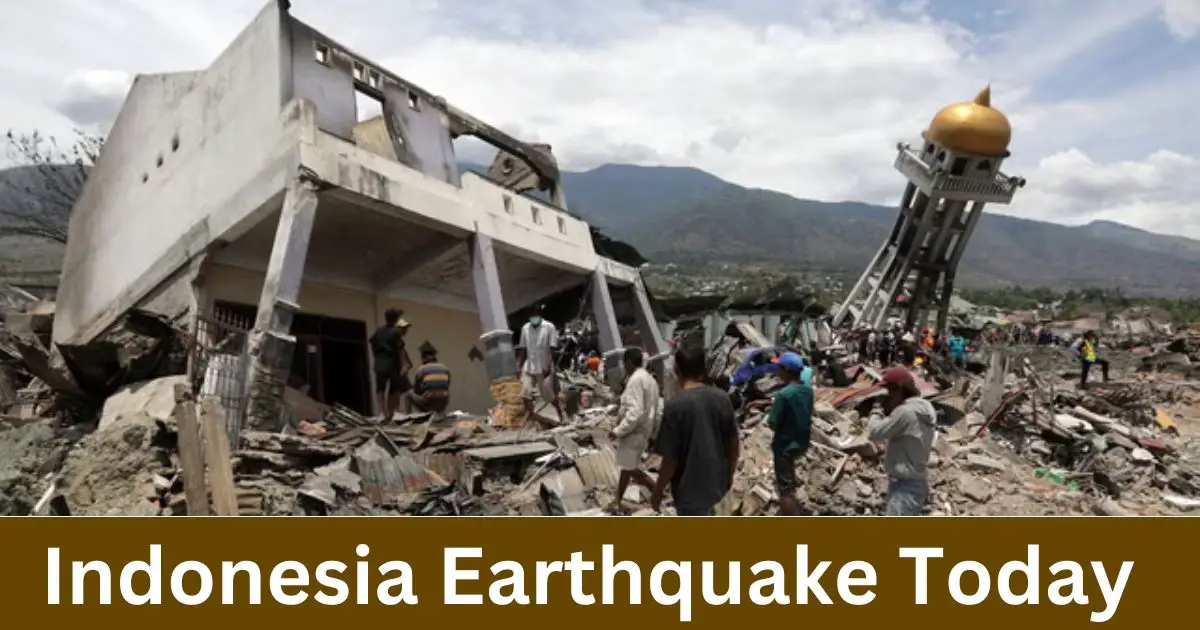An indonesia earthquake today of a magnitude of 6.2 occurred 70 kilometers below the surface in Java. Natural disasters are a stark reminder of the Earth’s dynamic nature and the vulnerability of human settlements to its forces.
On 28 april Java, Indonesia, experienced a significant seismic event—a 6.2-magnitude earthquake that originated 70 kilometers below the surface. Despite its intensity, initial reports suggest that no damage has been reported so far. This event prompts a closer examination of earthquake preparedness measures in Java and underscores the importance of proactive strategies in mitigating the impact of such disasters.
Understanding the Geological Context
Indonesia’s Vulnerability to Earthquakes Indonesia, situated in the Pacific Ring of Fire, is prone to seismic activity due to its position along the convergent boundary of several tectonic plates. The collision and subduction of these plates result in frequent earthquakes and volcanic eruptions, making Indonesia one of the most seismically active regions in the world.
The Specifics of the Java Earthquake The recent earthquake in Java occurred at a depth of 70 kilometers below the Earth’s surface. Its magnitude, recorded at 6.2, indicates a significant release of energy. However, the depth at which it occurred could have influenced its impact on the surface.
Immediate Response and Assessment
No Reported Damage: An Initial Assessment Despite the intensity of the earthquake, the absence of reported damage raises questions about the effectiveness of early warning systems and preparedness measures in Java. Authorities and experts are currently assessing the situation to determine the factors contributing to this outcome.
Importance of Timely Communication Effective communication during and after a seismic event is crucial for ensuring public safety and coordinating response efforts. The absence of damage reports underscores the need for clear communication channels between relevant agencies and the public.
Factors Influencing the Impact
Depth and Magnitude The depth at which an earthquake occurs can significantly influence its impact on the surface. Deeper earthquakes may dissipate energy before reaching the surface, resulting in less severe shaking and reduced damage potential.
Building Codes and Infrastructure The implementation and enforcement of robust building codes are essential for reducing the vulnerability of structures to earthquake damage. In regions prone to seismic activity like Java, ensuring that infrastructure meets stringent safety standards is imperative.
Early Warning Systems Early warning systems play a critical role in alerting communities to impending earthquakes, providing valuable seconds or minutes for individuals to take protective actions. Assessing the performance of these systems during the recent earthquake can offer insights into their effectiveness and areas for improvement.
Preparedness Strategies and Resilience
Community Education and Training Empowering communities with knowledge about earthquake preparedness and response can enhance resilience and reduce the risk of injury and loss of life. Training programs on emergency procedures, evacuation routes, and first aid can equip individuals with the skills needed to navigate disaster situations effectively.
Strengthening Infrastructure Investments in resilient infrastructure, including retrofitting existing buildings and infrastructure to withstand seismic activity, are essential for minimizing damage and disruption during earthquakes. Collaborative efforts between government agencies, engineers, and urban planners are necessary to prioritize and implement these measures.
Coordination and Collaboration Effective disaster preparedness and response require coordination and collaboration among various stakeholders, including government agencies, non-governmental organizations, and the private sector. Establishing multi-agency task forces and conducting regular drills and simulations can improve coordination and ensure a swift and effective response when disasters strike.
Lessons Learned and Future Considerations
Evaluating Response Efforts In the aftermath of the earthquake, conducting a comprehensive evaluation of response efforts can identify strengths and weaknesses in existing preparedness measures. Lessons learned from this experience can inform future strategies for enhancing resilience and reducing the impact of seismic events in Java and beyond.
Investing in Research and Innovation Continued investment in research and innovation is crucial for advancing earthquake prediction, early warning systems, and resilient infrastructure technologies. By leveraging scientific advancements, policymakers and practitioners can develop more effective strategies for mitigating the impact of earthquakes and improving community resilience.
Conclusion
The recent 6.2-magnitude earthquake in Java, Indonesia, serves as a reminder of the region’s susceptibility to seismic activity and the importance of proactive preparedness measures. While the absence of reported damage is encouraging, it also highlights the need for ongoing efforts to strengthen resilience and enhance response capabilities. By investing in education, infrastructure, and collaboration, Java can mitigate the impact of future earthquakes and build a more resilient society capable of weathering natural disasters.

